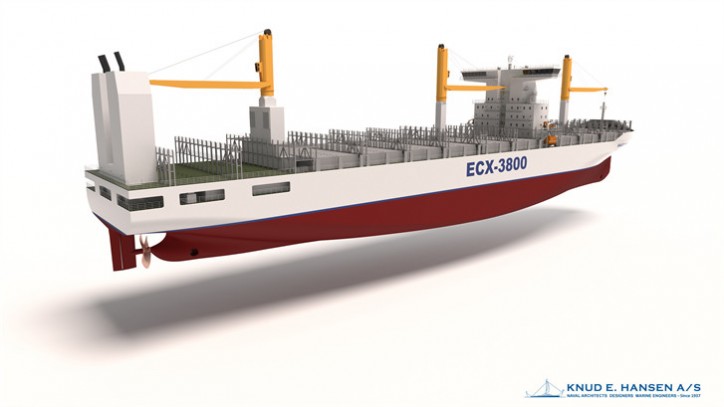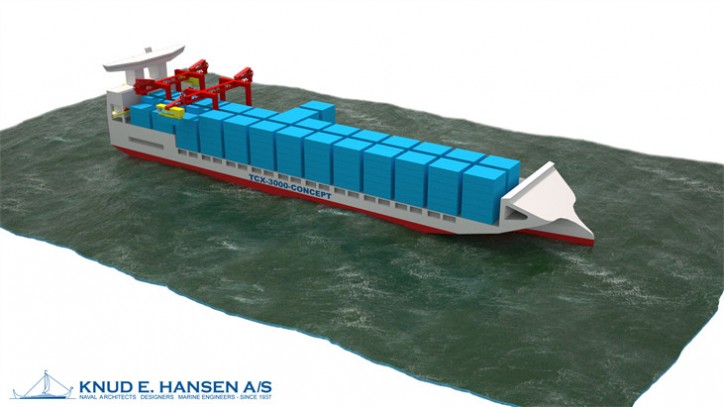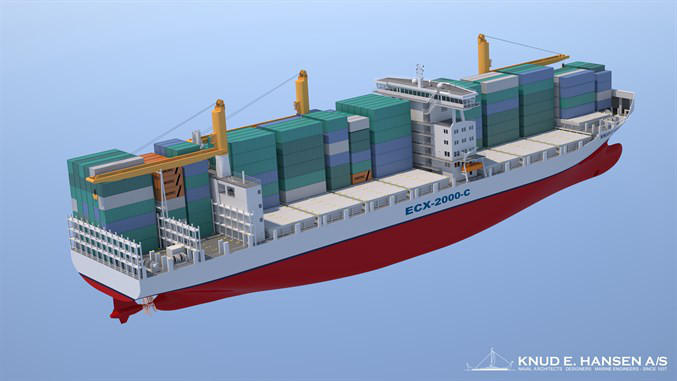Danish Company Unveils Three New Container Feeder Design
KNUD E. HANSEN, a Danish naval architect company, has been developing a number of pioneering container feeder vessel designs, tailored to meet specific requirements.
In order to navigate harbors which requires a vessel to have shallow draught – like in case of Bangkok, the Danish designers presented this first design – a special propeller arrangement employing a directly driven main propeller with a diameter of 5.8 m and a counter-rotating Azipod with a 4.7 m propeller.
The Second design anticipates a vessel which does not require such a shallow draught and which will have a 3,800 TEU capacity. This design sees the feeder vessel fitted out with a larger diameter, slower-turning propeller, with draught not being a primary consideration. The deckhouse of this vessel is positioned slightly forward of amidships to maximize the number of container slots on deck considering the IMO requirements to the line of vision from the bridge. The added number of slots can be utilized in real-life loading conditions because the vessel is wider and has a higher stability than most feeder vessels of this size.
The sketch below shows how the vessel can be converted:
A: Fuel tanks arranged below the deck house
B: Converted for dual-fuel – Membrane LNG tanks installed in former HFO tanks
C: Prefabricated tri-lobe C-type LNG tank installed in former HFO tanks
The third arrangement sees the application of an innovative hull shape suited for carriage of both partial and full container loads. The problem arises due to the differing ways in which a vessel behaves based upon its load. A large container vessel, when carrying few containers, offers shallow draught, but has so much stability that accelerations are too high, causing problems for the lashing gear and the crew.
Proposed Solutions:
Instead of the conventional hull(A), we have:
- A hull with inclined slides(B)
- Mirror the triangular sections in each side to create a trimaran or in better words a “stabilized mono-hull” with a narrow main hull with vertical sides(C)
- Outrigger hulls with a triangular cross section, but vertical sides towards the quay (D)
Highlights:
- These narrowness associated with low accelerations at partial load, and with the triangular section of the outrigger hulls, increased stability for full loads at deeper draught.
- The design features an open top section in the main hull, with 40ft containers stacked in a fixed cell guide system. Because cell guides are not fitted outboard the main hull above the outriggers, the loading flexibility with regard to carrying 20, 45 and 48ft containers has been addressed.
- Because the main hull is narrow, the sides of the open-top holds can be lower, and with lower sides, faster container handling.
- When the vessel is not heeling, the sides barely touch the surface of the water, meaning little resistance. This ensures a vessel which can have a relatively high service speed while maintaining a reasonable fuel consumption per container, per nautical mile.
To Watch video please visit here



Source: Knud E. Hansen A/S



















